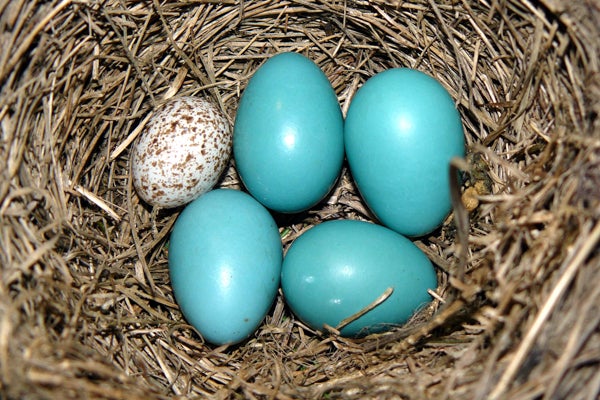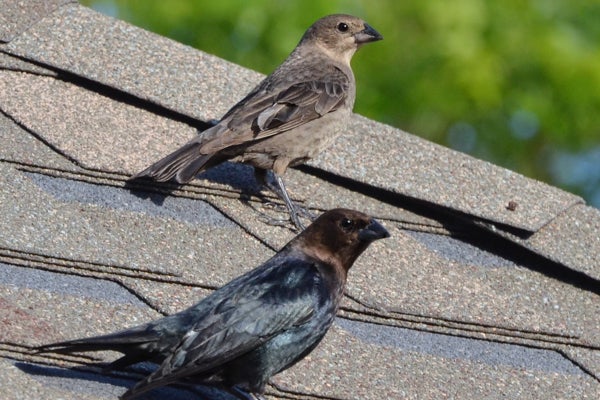Freeloading mother birds force others to raise their hatchlings
Listen
An American robin sits on her eggs in her nest. She has to be vigilant or a cowbird may try to put a parasitic egg in her nest. (Paige Pfleger/WHYY)
The brown-headed cowbird is one of the most hated birds in the entirety of the animal kingdom.
Each springtime, when most birds are settling down to build their nests, the cowbird is sneakily plotting its attack.
“They hide, they spend a lot of time looking for nests, and they don’t reveal themselves until they absolutely must,” Mark Hauber says. He’s a professor of animal behavior at Hunter College in New York City.
Cowbirds are looking for nests of other birds because they’re what’s known as a brood parasite: A cowbird mom lays her eggs in the nests of other birds. Only about 1 percent of all bird species get others to raise their babies.
“Parental care is costly,” Hauber says. “It takes a lot of time to look after your eggs. And so if you can save the cost of parental care by becoming a parasite and sneaking your eggs into other birds nests, you can save a tremendous amount of energy, and time.”
Among that 1% of birds, the cowbird is especially notorious — most brood parasites only leave their eggs in the nest of one type of bird, but the cowbird is a generalist, laying eggs in over 200 different nests.
And cowbirds don’t just ditch their eggs in a nest and leave. Scientists have found that they take it much further.
Let’s say an American robin comes back to her nest and notices that there is a white speckled cowbird egg in with her bright blue ones. So she decides to toss it out of the nest. Little does she know, mama cowbird has been watching.
 A brown speckled cowbird egg in with an American robin’s eggs. (Courtesy of Mark Hauber)
A brown speckled cowbird egg in with an American robin’s eggs. (Courtesy of Mark Hauber)
“It monitors the nests of the hosts in which it laid eggs, and destroys the nest of the hosts that have rejected the cowbird egg,” Hauber says. “We call it retaliation, or the mafia strategy.”
That’s right, a bird mafia. Except instead of an eye for an eye, it’s an egg for an egg.
Researchers have even found that if that mother robin tries to build a new nest, that same cowbird will come back and start the whole cycle over again. Robins and other birds haven’t developed a defense strategy to protect against cowbirds yet, because parasitism from a cowbird is so random.
Essentially the cowbird mom is pulling a Don Vito Corleone, making the robin an offer she can’t refuse: Either she raises the cowbird chick alongside her own babies, or she loses all the eggs all over again.
The cowbird has even evolved a way to fight against competition in the nest, if the robin decides to raise it. It hatches earlier than the other eggs, it’s bigger, and it cries louder for food.
“When there are more begging beaks in the nest, the parents bring more food. But what happens is the cowbird raises its head higher, so it gets more of the food than the parents would give to their own young,” Hauber says.
The cowbird baby leaves the nest before the baby robins, and the nest mom follows it, giving it food as it explores the forest. And eventually, the baby robins in the nest starve to death.
And then the cowbird twists the knife one last time — after all the nest mom has done for the cowbird baby, after her own biological young have died, the cowbird leaves.
 A male (below) and female (above) brown-headed cowbird. (Photo via Wikimedia Commons)
A male (below) and female (above) brown-headed cowbird. (Photo via Wikimedia Commons)
“It undergoes what we think is an anti-imprinting process. It actually avoids the foster species and tries to seek out its own species,” Hauber says.
It uses a particular call to locate other cowbirds who teach it how to be a cowbird instead of a robin, including how to parasitize a nest, starting the cycle all over again.
That leaves the nest mom all alone, with no babies to show for all of her hard work.
And that’s a really bad case of empty nest syndrome.
WHYY is your source for fact-based, in-depth journalism and information. As a nonprofit organization, we rely on financial support from readers like you. Please give today.



